Tuesday, March 30, 2004
A gorgeous bougainvillea
When my husband and I went to the Bahamas many years ago, we saw the most gorgeous vines growing up the sides of the hotel. The blooms were abundant and an intense fuchsia color. We vowed that if we ever figured out what the plant was and could grow it at home, we would do so.
I finally stumbled across a picture of the plant years later after we had relocated to Florida and found out they were bougainvillea vines. Ever since I have had this luscious vine growing in my garden.
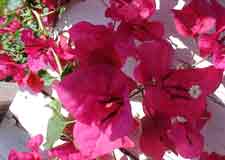
Nyctaginaceae is an evergreen shrubby vine native to the tropics. The color comes not from its tiny flowers, as shown in the picture, but from the three large bracts that surround them. The vines produce a variety of colors from white to yellow orange, red, pink, lavender as well as combinations of colors.
When planting, be sure to provide a sturdy support as the vine will become heavier as it grows. If you would prefer not to stake bougainvillea, it can act as a sprawling shrub with good pruning. Be careful of the stems when handling as it produces sharp thorns.
Plant in sun and fertilize in spring and summer. Water normally throughout the growing season and don't be afraid to prune bougainvillea after it blooms. It will help renew the plant, provide shape and direct its growth. In northern climates, bougainvillea can be container grown. Spring Hill Nursery carries the Raspberry Ice variety. Click on the blinking icon to the right for more information.
Happy Gardening and watch out for those thorns.
I finally stumbled across a picture of the plant years later after we had relocated to Florida and found out they were bougainvillea vines. Ever since I have had this luscious vine growing in my garden.

Nyctaginaceae is an evergreen shrubby vine native to the tropics. The color comes not from its tiny flowers, as shown in the picture, but from the three large bracts that surround them. The vines produce a variety of colors from white to yellow orange, red, pink, lavender as well as combinations of colors.
When planting, be sure to provide a sturdy support as the vine will become heavier as it grows. If you would prefer not to stake bougainvillea, it can act as a sprawling shrub with good pruning. Be careful of the stems when handling as it produces sharp thorns.
Plant in sun and fertilize in spring and summer. Water normally throughout the growing season and don't be afraid to prune bougainvillea after it blooms. It will help renew the plant, provide shape and direct its growth. In northern climates, bougainvillea can be container grown. Spring Hill Nursery carries the Raspberry Ice variety. Click on the blinking icon to the right for more information.
Happy Gardening and watch out for those thorns.
Saturday, March 27, 2004
Going batty for bats
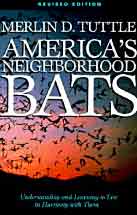 I am fascinated by bats! Whenever my husband and I would sit outside at dusk, I would look up and see what I thought were birds rushing to go home for the night. My husband set me straight pretty quickly and, ever since, dusk has been a favorite time of day for me as I watch the bats flitter through the trees.
I am fascinated by bats! Whenever my husband and I would sit outside at dusk, I would look up and see what I thought were birds rushing to go home for the night. My husband set me straight pretty quickly and, ever since, dusk has been a favorite time of day for me as I watch the bats flitter through the trees.
As I sat and watched the bats one evening, I thought it would be fun to have a bat house but didn't have the slightest idea on how to go about constructing one. The next day my husband surprised me with the greatest little book on how to do just that. America's Neighborhood Bats by Merlin Tuttle includes a wealth of information on building bat houses and attracting bats to your environment.
The only problem is my copy is lost, either as a result of our most recent move or I lent it to someone and never had it returned. So if you see a rather dog-eared copy laying around somewhere, it might just be mine. To get your own, click on the Books-a-Million icon on the right. Happy Gardening and go searching for bats in your neighborhood tonight. You'll be glad you did.
Thursday, March 25, 2004
Beautiful begonia blooms
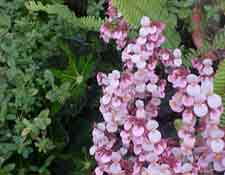 Have you ever seen anything more gorgeous than this? I woke up the other morning and there it was staring me in the face - my tuberous begonia was blooming! I've got to tell you the story about this little gal and how she got here.
Have you ever seen anything more gorgeous than this? I woke up the other morning and there it was staring me in the face - my tuberous begonia was blooming! I've got to tell you the story about this little gal and how she got here.
When my husband and I decided to move south (yeah, yeah you've heard this story before), I was loath to leave any of my plants behind. The movers agreed to take just a few potted plants on their truck to drive down along with our furniture. Well, give a gardener an inch and they'll take a square foot -- so I loaded about 25 pots onto the truck and the begonia was one of them.
The plants arrived gasping for light and water, but still none the worse for wear. The begonia held a place of prominence on our outside dining table and flowered every spring. My folks were visiting not too long after we moved and my mother was admiring the begonia. It needed to be divided anyway, so I gave her a piece and put the rest in a new pot.
Mrs. Begonia thrived and grew and eventually needed a new pot. Well, when we moved to our new house about a mile away I decided it was time to give her a place to spread her roots the way she wanted. I have since divided her, and her twin sister abodes in another shaded area of the front garden. Mrs. B gets great light but not directly as she is protected by a Canary Palm (that's an article for another time) and is blooming to beat the band.
What I really love about Mrs. B is that not only are her flowers pretty, but her leaves are lush and rich in color. They are irregularly lobed and "furry" with green in the middle and dark green on the surrounding edges. The more shade provided, the darker the leaves will color.
Begonia tuberosa (Mrs B for short), is named for the small, rounded tubers from which the plant grows. She originates from South America and does well in warmer climates outside. I grew her outside in a container up north in the summer, but brought her back in in the winter. Keep the soil relatively moist and she'll thrive happily. Flowers are offered in a wide range of colors from orange to crimson and some are much larger than the one pictured here. Happy Gardening, and adopt a tuberous begonia soon. You won't regret it.
Tuesday, March 23, 2004
I am refreshed

I LOVE being in my garden. There is nothing more enlivening for me than the first time I can start working in the fresh air. I finally got out this Saturday for the first time since early fall. Now, you may laugh to yourself and say hey, girlfriend, you live in Florida. Why haven’t you been out all winter? Well, let me tell you.
When one lives in Florida, one’s blood does thin. When I lived up north and would vacation here, I would laugh at the “natives” all wrapped up in their sweats. I have learned from experience that everyone adapts to his or her environment. Consequently even though temperatures here are higher generally than elsewhere in the winter, I’m still wrapped up in sweats sans mittens or coats. And spend more time indoors in the cooler months. I never thought I would confess that, but just keep it under your hat.
Anyway, back to my story. So, Saturday was the first real day I was working in the yard and boy did I feel it. I was cleaning debris from all the construction stuff and trimming grass, etc. I got tired out pretty quickly and settled for spending the afternoon sitting by the pool (don’t you feel sorry for me?). Sunday, my stamina was a bit better and allowed me to work a few more hours until the backyard was much more orderly. It’s now a lovely bare canvas for me to begin planning my wildflower and native plant garden down to the water’s edge.
The reason I share all of this is because I’m sitting here Tuesday night and still feeling the “high” from my first real weekend communing with nature. It is what I need to be connected to something greater than I that makes life so worthwhile. The coming weekend promises to be more clearing and planning, but I’m ready for it. And I can definitely say I will not be wearing my sweats! Happy Gardening.
Monday, March 22, 2004
Call me crazy
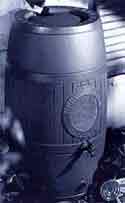
My husband and I were talking the other day about how we planned to fashion our gardens now that the construction trucks were no longer running over the flowerbeds and destroying everything in sight. As we chatted, we both came to the conclusion that we really needed to start using rain barrels as an irrigation source. It had to have a hose adapter so that we could connect a soaker hose (many barrels have spigots but no adapter) and had to hold a lot of water but be unobtrusive in size and color.
While I was researching the choices, my mother called to chat. I told her what we were planning to do and she told me I was crazy. “Why go through all that work when you could just hook the hose to the waterbib and set up the sprinklers?” she asked. Well, call me crazy but water conservation makes sense. Our reasons to commit to this are many. First, our water resources are not as plentiful as we perceive they are. Roughly 97% of the world's water is salty or otherwise undrinkable leaving a small percentage for human needs including agricultural, residential, manufacturing, community, and personal needs. Many factors affect our water from population growth to drought conditions. Second, our house has a lot of run off when it rains. The water winds up standing in the areas where we need to walk to access the backyard and eventually seeps into the storm drain. Third, here in Florida we are restricted to the day and time we are allowed to water, which wreaks havoc with new plantings or more needy ones. Also, if we exceed the amount of water our water company thinks we should be using on average, we are charged a high water usage fee. So why not harness nature’s gift by using a rain barrel?
Anyway, I did a lot of research and came up with the perfect solution from Yardiac (you can access their site using the icon on the right). The Spruce Creek Rain Saver is dark green so it doesn’t stick out like a sore green thumb against the house. It holds 54 gallons of water and has an overflow on the back so we don’t have to check it if there is a hard rain. It has two access areas so we can have the spigot hook up as well as the garden hose connected. It comes with a 5-year guarantee and it’s just in our price range - $139.
So, the moral of the story is this. Call me crazy, Mom, but just wait until you see my beautiful gardens this year. You’ll be green with envy! Happy Gardening.
Friday, March 19, 2004
Shirley stumped me
My mother-in-law just moved to Florida a few weeks ago to a 55+ community about a mile from our home. While we were waiting for her to arrive and going over to check on her place, my husband and I had the pleasure of meeting her across-the-street neighbors. Shirley and Bob hail from Rhode Island and have lived in this neighborhood for about a year. They are avid gardeners and, when looking for their place, ensured they purchased a home on the lake with a huge back yard.
My husband dropped by to see his mother the other day and Shirley was outside. They got chatting and the conversation came around to gardening and this site. Shirley posed her question and my husband assured her I could find the answer. The question was how could she remove black fungus on the rocks surrounding her garden. She had visited her local large home warehouse and they recommended bleach. Shirley, in her environmentally sound wisdom, refused to accept that as a solution and wanted something that would not harm her plants or the environment.
I have combed through my entire garden library and many online sites, and must admit I’m kind of stumped. I have found everything one would ever need to know about plant diseases and pests, but little about fungus on hard surfaces. However, I think I’ve come up with the solution. Everything I’ve been reading keeps pointing me to a mixture of 5 tablespoons each of hydrogen peroxide and baking soda mixed with one gallon of boiling water. Spray this mixture directly on the fungus and it should kill it off without harm to the surrounding plants.
Shirley, I hope this helps and if anyone reading this has a better idea, please share. I’d look forward to hearing about it.
My husband dropped by to see his mother the other day and Shirley was outside. They got chatting and the conversation came around to gardening and this site. Shirley posed her question and my husband assured her I could find the answer. The question was how could she remove black fungus on the rocks surrounding her garden. She had visited her local large home warehouse and they recommended bleach. Shirley, in her environmentally sound wisdom, refused to accept that as a solution and wanted something that would not harm her plants or the environment.
I have combed through my entire garden library and many online sites, and must admit I’m kind of stumped. I have found everything one would ever need to know about plant diseases and pests, but little about fungus on hard surfaces. However, I think I’ve come up with the solution. Everything I’ve been reading keeps pointing me to a mixture of 5 tablespoons each of hydrogen peroxide and baking soda mixed with one gallon of boiling water. Spray this mixture directly on the fungus and it should kill it off without harm to the surrounding plants.
Shirley, I hope this helps and if anyone reading this has a better idea, please share. I’d look forward to hearing about it.
Wednesday, March 17, 2004
A.R.F. or Amaryllis Rescue in Florida
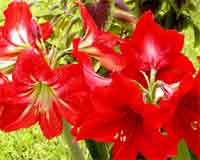
I emailed my friend, Liz Donovan, the other day to let her know about the most recent Florida gardening articles posted to this site. She responded by telling me she too had just returned from North Carolina and was seeing daffodils sprouting. She then went on to mention a multi-flowered amaryllis she has blooming in her yard. It seems that Liz successfully performed amaryllis rescue – she rescued the bulb from her neighbor’s yard last year before they bulldozed the place to build a new house. Obviously the amaryllis was very appreciative of her good deed and has been rewarding her with magnificent blooms.
As I mentioned in an earlier article, amaryllis is our substitute for tulips here in the sunny south. Hippeastrum vittatum hails from Peru and is one of the best performing bulbs for this state. It is planted from October through February, and produces flowers from as early as March through May. (It generally takes about two months from the time of planting to the time of blooming.) Its trumpet-shaped flowers can be as large as 6-8 inches in width and are borne in clusters of two to five. Leaves are strap-shaped and about an inch broad and up to 2 feet long. Flower colors range from white to red in solid and striped colors.
Amaryllises (I want to say amarylli but it’s not correct) prefer partial shade and should be planted with one-third to one-half of the bulb above the ground. After multiplying for a few years, the bulbs can be lifted, separated and replanted in a new bed with amended soil.
If you ever get a chance to perform amaryllis rescue, it will definitely be worth it for the gorgeous blooms. If your neighbors won't share, visit one of the bulb resources listed on this site. Happy Gardening and keep an eye out for the bulldozers.
Monday, March 15, 2004
How to survive transplanting
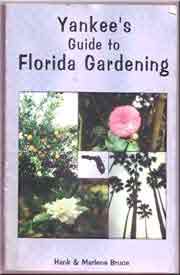
I was chatting with my chiropractor the other morning about this website and our shared love of gardening. In between adjustments (gotta get that spine straightened out), Dr. Lovett mentioned he’d only lived in Florida about 4 years so wasn’t sure where he would begin with his new yard. That comment reminded me of when my husband and I made our roots here 8 years ago.
Before we moved we subscribed to the St. Petersburg Times to learn more about the area. One morning I stumbled across an article about Florida gardening books and, to my delight, found exactly the reference source I needed, The Yankee’s Guide to Gardening by Hank and Marlene Bruce. The first thing I learned when I opened it is that all my years of northern gardening knowledge had to be thrown out the window. Why? Because:
- my northern soil was clay and I was moving to sand.
- my planting zone was 7 and I was moving to 10.
- my planting time was changing from spring to fall-winter (yes, winter).
- many of the plants I came to rely on for lasting beauty would burn to smithereens here.
A few examples of northern favorites:
Lilac
Clematis
Tulips
Bleeding Heart
Forsythia
and their substitutes:
Crape Myrtle
Passion Vine
Amaryllis
Clerodendrum Vine
Thryalis
The Yankee’s Guide to Florida Gardening is a wealth of information for gardeners planning relocation, and I highly recommend it. You’ll note the dog-eared look of my copy in the picture. This informative resource tackles everything from Florida soils to “the funny stuff growing in the trees” (it’s Spanish moss) and can be found at Barnes & Noble or Amazon.com. Happy Gardening and watch out for that stuff in the trees.
Sunday, March 14, 2004
Being connected

I don't know about you, but I vaguely remember what it was like not to have a computer as little as 10 years ago. Now I don't know what I would do without it. It keeps me connected to lots of helpful information and it assists me in producing this site, my biggest pleasure in life next to my family and friends.
Ever since we've had computers in our family and traded up and traded up again for more memory or a bigger hard drive or a fancier keyboard, we've been stumped on exactly what to do with the preceding models. Previously we've shared them with family members who didn't have a computer, but now that we are planning to trade up again what do we do with the three we currently have?
My husband and I have both been very concerned with the impact to the environment since these products contain materials such as lead, mercury, cadmium, and nickel, to name a few. Well, I was reading my latest copy of Better Homes and Gardens (I LOVE this magazine) and there was an article entitled "New Life for Old Tech". It speaks to the exact issue with which my husband and I have been struggling and provides some solutions. Apparently many major computer manufacturers and sellers have started collecting old computers and printers to promote recycling. Companies such as Dell and Hewlett Packard have online programs for recycling and trade-in. Sellers such as Best Buy have special collection weekends allowing drop off of old computers as well as TVs and VCRs. It appears that all the programs mentioned have a small fee involved, but it's worth it to preserve the environment. There are also a few non-profits who will gladly accept the old electronics and refurbish them for resale.
To learn more, pick up the April issue of Better Homes and Gardens. Happy Gardening and thanks for considering recycling.
Thursday, March 11, 2004
Spring is breaking in the Carolinas

I haven't posted any notes in the last few days because I've been traveling. I left the warm south and traveled up the east coast to North Carolina where the temperature was about 25-30 degrees lower than my hometown. While I shivered in my boots and prayed that the forecasted snow would miss its intended path (it did, thank goodness), I was still awed by the beginnings of spring I noticed everywhere.
The air was crisp but contained that quality that indicates warmer weather is on the way. The trees were just beginning to bud, and I saw some crocuses starting to peak out. My taxi driver was very excited to tell me about the dogwood trees lining the route to the airport and the various colors they would bring in the next few weeks.
In my former home up north, I was lucky enough to tend a pink flowering dogwood tree. Each spring it would reward us with the most beautiful rosy pink bracts I had ever seen. Shortly thereafter, it would offer shade to sit and contemplate my next plantings. I really miss that tree and the years we spent making that garden an extension of ourselves. But we're doing the same here and I'll have many upcoming stories to share.
Cornus florida is a flowering dogwood tree native to the eastern United States. The tree can reach as high as 40 feet, but is generally in the 20-30 feet range. Dogwood trees are covered with flowers in midspring before their oval leaves come forward. Leaves are 2-6 inches long and about 2 1/2 inches wide, bright green above and lighter on the underside.
Flowering dogwood grows well in full sun but should be planted in deep, fertile soil that retains moisture. Zones will vary by species. For more growing tips, I recommend visiting Clemson's Home and Garden Information Center. A great purchasing resource is Nature Hills Nursery. Happy Gardening and remember, Spring is just around the corner.
Sunday, March 07, 2004
The breathtaking Bauhinia blakeana
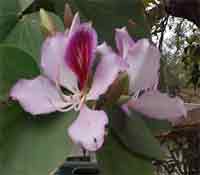
The other day my husband and I were driving through a neighborhood new to us when we stumbled across one of the most gorgeous flowers we have ever seen here in Florida. The flowers, produced by the Orchid tree (Bauhinia blakeana), grow up to 3-4 inches across in shades of white, red, purple, and pink. This deciduous tree is grown in central and south Florida and can reach a height of 25 feet. Leaves are quite large and round.
I've done some digging around (no pun intended) and learned that the tree's flower is actually known as the emblem of Hong Kong. The flower of Bauhinia blakeana was adopted in 1965 and since 1997 has been part of their regional flag. The tree was originally described as a new species in 1908 after being discovered on the shore of Hong Kong Island near Pokfulam around 1880 and was named after a Hong Kong governor, Sir Henry Blake, who apparently had a strong interest in botany. The photo displayed here is courtesy of my husband, press editor of The Green Cutting Board.
Thursday, March 04, 2004
Water gardening with lotus

As I was drifting off to sleep last night, I heard in the background the soothing sound of the pool’s waterfall. That sound reminded me how eager my husband and I are to build a water garden. We haven’t had one since we moved south about eight years ago. We didn’t have the room at the other house so kept putting it off. But now we can finally have a beautiful pond by incorporating it into the new landscaping around the pool.
I still have all my reference materials on how to build a water pond, what kind of fish will thrive, what water plants to choose, etc., etc. I can’t wait to start leafing through my books and making notes on what will work best in our space.
Two of the best references for water gardening we have in our gardening library are:
- Garden Pools and Fountains, by Ortho Books
- Garden Pools, Fountains and Waterfalls by Sunset Publishing
Both books provide easy step-by-step instructions for installing garden pools, large or small. Both offer design tips as well as comprehensive ideas on growing water lilies, lotus, and other aquatics. Additionally, they help the reader to understand what fish will be best for their plan.
Using these books, we built a beautiful water garden in our old house and had a number of Comets (a variety of goldfish) who reproduced approximately 2 times per year (although it seemed like it was much more often). We had marginal bog plants such as dwarf papyrus and arrowhead as well as a variety of water lilies and floating plants like shellflower and water hyacinth (pretty invasive in warmer climates but is killed back up north by frost). I will never forget when we finally purchased a Lotus (Nelumbo) plant called Momo Botan. I carefully researched the best lotus for our pond – it had to be a smaller size than other lotus, but produce beautiful flowers. That’s what Momo Botan (N. nucifera) does. The plant yields deep pink double blossoms resembling peony flowers that measure about 6 inches across. It is smaller than other lotus, with 1-18 inch wide foliage. To compare, some lotus actually stand 3 to 5 feet above the water with leaves 1-2 feet across. Momo is hardy in zones 5-10 and an excellent choice for small to medium-sized ponds.
I so look forward to a larger pond here in our new house and introducing one or two smaller lotus to the landscape. The Shirokunshi (N. nucifera) is also more compact and produces creamy white 6-8 inch wide, tulip-shaped flowers that are quite fragrant. If I pair that with the Momo Botan, I will have a gorgeous water garden to enjoy. I just hope the little Comets we introduce will agree and enjoy their new surroundings. We’ll keep you posted.
In the meantime, there are many great sources of information on water gardening such as LilyPons Water Gardens and Eponds. I hope you'll be listening to the relaxing trickle of water soon. Happy Gardening.
Wednesday, March 03, 2004
Nurturing the body through gardening
I got up a bit early this morning to go see my chiropractor and massage therapist whom I’ve been visiting for about 3 months now. An auto accident precipitated my forming this relationship and I must admit I was a bit skeptical when I was first referred to their office. But how my opinion has changed.
Dr. Gordon Lovett, my doctor at The Spinal Correction Centers, has been tremendous in adjusting my spine back to the way it was when I was a girl. Lynn Ginocchio and Chris Burlei, my phenomenal massage therapists, perform deep muscle massage to aid in getting me back to a healthy state.
So what, you may ask, do chiropractic medicine and massage therapy have to do with gardening? Pretty much everything. If your body frame is healthy you can comfortably work in the garden and nurture your plants. To reduce the likelihood of injury from twisting and turning activities like shoveling and hoeing, regular chiropractic visits can help keep muscles and vertebrae in top condition.
One of the BEST gardening articles I’ve read lately actually comes from Dr. Lovett’s office. I know he doesn’t mind if I paraphrase, so here are some comments:
So, the bottom line is love your garden but love your body just as much. And at my age, and I’m not saying what it is, I feel so much better structurally than I ever did at 20+. But don’t take my word for it. If you’re ever in Dunedin, Florida I invite you to find out for yourself (727-734-7611). But whatever you do, make sure you include the massage with Chris or Lynn. Those two have hands like God – you will melt on the table. Happy Gardening.
Dr. Gordon Lovett, my doctor at The Spinal Correction Centers, has been tremendous in adjusting my spine back to the way it was when I was a girl. Lynn Ginocchio and Chris Burlei, my phenomenal massage therapists, perform deep muscle massage to aid in getting me back to a healthy state.
So what, you may ask, do chiropractic medicine and massage therapy have to do with gardening? Pretty much everything. If your body frame is healthy you can comfortably work in the garden and nurture your plants. To reduce the likelihood of injury from twisting and turning activities like shoveling and hoeing, regular chiropractic visits can help keep muscles and vertebrae in top condition.
One of the BEST gardening articles I’ve read lately actually comes from Dr. Lovett’s office. I know he doesn’t mind if I paraphrase, so here are some comments:
- Raking, weeding, planting seeds on hands and knees…these are just a few of the garden-related activities that may bring on back pain. Specifically, these repetitive activities are linked with a spinal disorder called vertebral subluxation.
- This common condition occurs when spinal movement is restricted or spinal bones (vertebrae) become misaligned. Vertebral subluxations are linked with a myriad of health concerns, such as backache, carpal tunnel syndrome, headaches, infantile colic and ear infections. Dr. Lovett can correct vertebral subluxations with safe and gentle maneuvers called chiropractic adjustments.
- Gardening is exercise and, just like any other workout, a proper warm-up is vital to staving off injury. Just five to ten minutes of stretching before gardening can make a huge difference when it comes to preventing strains and sprains.
So, the bottom line is love your garden but love your body just as much. And at my age, and I’m not saying what it is, I feel so much better structurally than I ever did at 20+. But don’t take my word for it. If you’re ever in Dunedin, Florida I invite you to find out for yourself (727-734-7611). But whatever you do, make sure you include the massage with Chris or Lynn. Those two have hands like God – you will melt on the table. Happy Gardening.
Tuesday, March 02, 2004
Discovered friends along the path
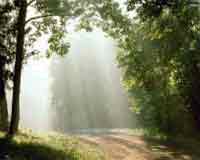
I am always so pleased by the number of nice people I have the privilege to meet as I go through my daily travels. And today is no exception. Some new gardening friends have come along that I must tell you about.
Kathy Purdy has a fabulous site I invite you to visit, Cold Climate Gardening. Kathy’s focus is to share all she knows, and that others share with her, about gardening in a cold climate. Now, I can relate since I lived up north for many, many years. I think you’ll enjoy Kathy’s site as much as I did. A few of the topics covered include book and catalog reviews; pests, plagues and varmints; and her wishlist. She, too, has a number of links to great gardening info so be sure to go out and visit her soon.
Mary Walters of Walters Gardens, a link already featured on our Information Sources page, responded to my email letting me know about two other informational sites she has – Perennial Resource, and Designer Daylily. Both sites feature growing information and garden center locators as well as some of the most beautiful photographs I’ve seen. Mary’s perennial site also features information on landscape design. Please be sure to visit Mary soon.
Finally, Liz Donovan, The Herald’s Research Editor, searches the Web for useful information and then posts links for the Herald’s staff and readers. She has a pretty healthy collection of articles about a variety of topics and I encourage you to also go visit her site.
Kathy and Mary have been added to our Information Resources page and Liz has taken a spot among our Friends and Fellow Travelers links. I plan to share many more sites with you as my circle of friends grows. Happy Gardening.
Monday, March 01, 2004
Wake up and smell the orange blossoms
Did you ever have one of those early mornings where you just wake up and can’t fall back to sleep? It happened to me about two weeks ago, and long about 5:30 AM I decided to just get up and get the coffee started.
Once the dogs and cats were fed and my first cup of coffee was in hand, I slowly moved out to the deck to watch the sun come up. And am I ever glad I did. The air was cool but warm enough to be cozy in a bathrobe and the stillness at that time of the morning was awe-inspiring. I just sat there quietly with the dogs watching the birds awake and the ducks moving their family slowly through the water behind our house. What a beautiful experience it was, and it gave me an opportunity to get back in touch with what’s really important, for me, in life.
Anyway, I mentioned orange blossoms. We live in the South and have an orange tree next door. We used to have our own until we moved, so now we just enjoy the neighbor’s. The scent from the orange tree at this time of year is absolutely incredible. It’s better than the best perfume you could ever smell. And when the flowers are gone, the fruit is one of the most rewarding sights you can experience as a gardener. So, here’s some info about orange trees:
Oranges are considered a tender fruit in that they are generally grown in hot climates. They may still be grown in cooler climates but usually in containers or under cover as long as the correct temp and humidity levels are maintained. In northern climates orange trees may not consistently ripen undercover, but do make attractive ornamentals.
During the first few years, citrus trees need to be fed a balanced fertilizer with a high nitrogen and medium potassium level at a rate of about 2 lb per tree per year. When the trees are in active growth fertilizer should be applied in two or three doses at regular intervals around the base of the tree. After five years, the quantity of fertilizer should be doubled.
Several places sell orange trees including home improvement warehouses. Of course, if you don't want to grow them you can always order the tasty fruit through many companies such as Orange Blossom Groves here in Florida.
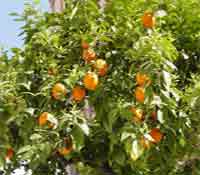
Happy Gardening. and remember to take the time to smell the orange blossoms!
Once the dogs and cats were fed and my first cup of coffee was in hand, I slowly moved out to the deck to watch the sun come up. And am I ever glad I did. The air was cool but warm enough to be cozy in a bathrobe and the stillness at that time of the morning was awe-inspiring. I just sat there quietly with the dogs watching the birds awake and the ducks moving their family slowly through the water behind our house. What a beautiful experience it was, and it gave me an opportunity to get back in touch with what’s really important, for me, in life.
Anyway, I mentioned orange blossoms. We live in the South and have an orange tree next door. We used to have our own until we moved, so now we just enjoy the neighbor’s. The scent from the orange tree at this time of year is absolutely incredible. It’s better than the best perfume you could ever smell. And when the flowers are gone, the fruit is one of the most rewarding sights you can experience as a gardener. So, here’s some info about orange trees:
Oranges are considered a tender fruit in that they are generally grown in hot climates. They may still be grown in cooler climates but usually in containers or under cover as long as the correct temp and humidity levels are maintained. In northern climates orange trees may not consistently ripen undercover, but do make attractive ornamentals.
During the first few years, citrus trees need to be fed a balanced fertilizer with a high nitrogen and medium potassium level at a rate of about 2 lb per tree per year. When the trees are in active growth fertilizer should be applied in two or three doses at regular intervals around the base of the tree. After five years, the quantity of fertilizer should be doubled.
Several places sell orange trees including home improvement warehouses. Of course, if you don't want to grow them you can always order the tasty fruit through many companies such as Orange Blossom Groves here in Florida.

Happy Gardening. and remember to take the time to smell the orange blossoms!

This work is licensed under a Creative Commons License.
Thanks to Andrew Stenning who contributed the photograph for our masthead


